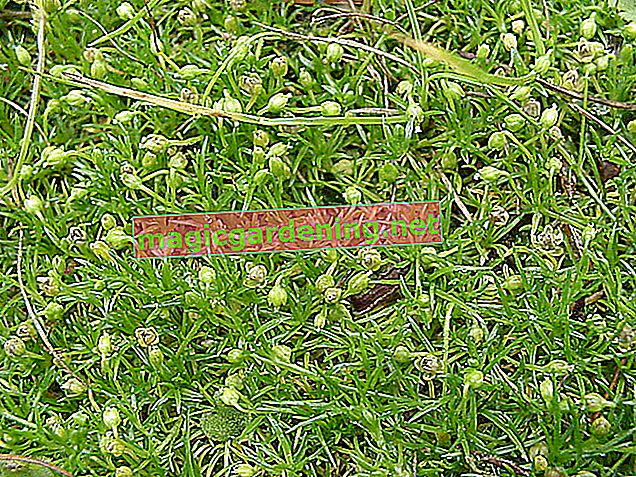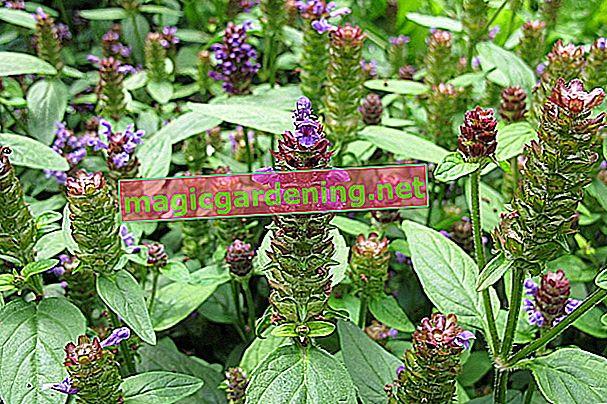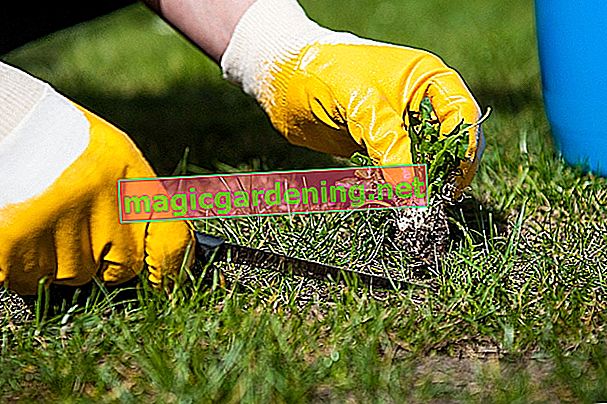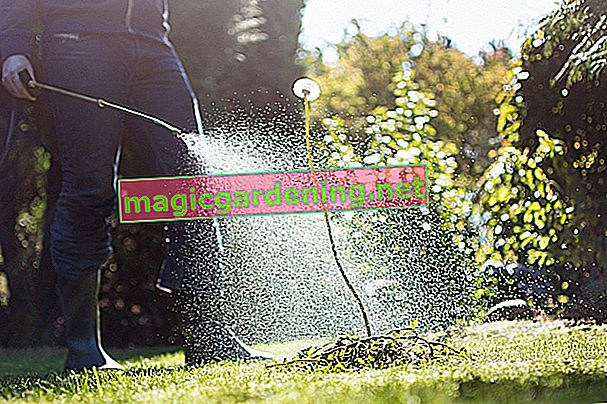
the essentials in brief
- Weeds often grow due to lack of nutrients
- Fertilizing and scarifying prevent weeds; lime helps with acidic soil
- Weeds are best fought manually; the use of herbicides must be avoided
- Perennial weeds should be removed before seeds are formed
Top 10 Creeping Lawn Weeds - Identifiers
Creeping weeds in the lawn are characteristic of prostrate growth with numerous, epic long runners. The undesirable plants owe their name to this property. Of course, this knowledge is not sufficient for a successful fight. If you want to cross the blades victoriously with the stubborn weeds, you should know the culprit by name. This list exposes the 10 most common creeping lawn weeds with important identifying features:
also read
- Fighting plantain in the lawn - How to remove the weeds with success
- Fighting weeds in the lawn - tips for correct scarifying
- Creeping cinquefoil: fight or tolerate and use?
| Surname | botanical name | Leaf shape | Growth length in cm | blossoms | Heyday | annual / multi-year |
|---|---|---|---|---|---|---|
| Gundermann | Glechoma hederacea | kidney-heart-shaped, notched, hairy | 10-50 | bluish-purple bell flowers | April to July | perennial |
| Giersch | Aegopodium podagraria | ovate, tripartite pinnate, serrated | 30-100 | white, flat umbels | June to July | perennial |
| Creeping Gunsel | Ajuga reptans | egg-shaped, shiny on top | 10-30 | blue, pink, white sham whorls | April to June | biennial |
| Creeping buttercup | Ranunculus repens | threefold pinnate, toothed | 10-50 | golden yellow, fivefold | May to September | perennial |
| Little Braunelle | Prunella vulgaris | elliptical, notched, evergreen | 5-30 | blue-violet, five-fold, cup-shaped | June to October | perennial |
| Meadow clover | Trifolium pratense | fingered in three parts | 15-60 | red spherical flowers | April to October | one to two years |
| White clover | Trifolium repens | threefold fingered | 5-30 | white spherical flowers | May to September | perennial |
| Chickweed | Stellasia media | ovoid tapering to a point | 3-40 | white star blossoms | May until October | annual |
| Thread Speedwell | Veronica filiformis | round, small | 10-50 | sky blue | March to June | annual |
| Hornwort | Cerastium | elongated to round | 5-30 | many colours | April to September | annual or multi-year |

Primarily the shape of the leaves reveals which creeping weeds are taking over your lawn. The shape and color of the flower also provide meaningful information. If this table has put you on the right track, consult the relevant article on Wikipedia. Here you can read important identifying features such as the arrangement of the leaves, color of the leaves above and below, flower shape and flower color.
As this table shows, perennial species dominate the top 10 creeping lawn weeds. Fatally, you have to deal with extremely stubborn rivals at Gundermann et al. Annual weed species give in more quickly and can be relegated to the green field with simple control methods.
In the fight against Giersch and Gundermann the futility of human activity is revealed.
Destroy perennial, creeping lawn weeds
The most promising control strategy against perennial, creeping lawn weeds depends on the infestation stage. In the early stages with local weed nests, a different approach is advisable than when spreading over the entire lawn. A tried and tested step-by-step guide is dedicated to both variants below. How to successfully control crawling weeds in the lawn:
Fight isolated weeds manually

The aim of manual control is to completely remove the mother plant and its long runners from the lawn. Pulling the weeds out of the ground by hand has only short-term success. Tiny root remains are sufficient for a new shoot. Instead, use a weed cutter. Use the V-shaped shovel to dig deep into the sward to lift any roots out of the ground. Follow the foothills with the weed cutter to the end and lift them together with their short root strands out of the lawn.
The tried and tested method is less strenuous if the lawn is well moistened. It is easy on the back with a weed cutter from Fiskar or Gardena. The functional principle is based on a combination of handle and gripping knives, which makes the annoying bending over unnecessary.
Destroy area-wide lawn weeds by machine
If creeping weeds spread over a large area in the lawn, you will be lost with a weed picker. Get a scarifier (€ 76.01 at Amazon *) as a mechanical help to fight ground grass, gundermann and other meandering wild herbs. How to properly scarify to remove creeping weeds from the lawn:
- cut the lawn
- Set the scarifier to a cutting depth of 3 mm
- Place the device on the lawn and switch it on
- Scarify a path, switch off the device and check the result
- If necessary, modify the cutting depth to 4 mm, maximum 5 mm
- Comb out weeded lawn lengthways and crossways (checkerboard pattern)
- Sweep the combed out lawn thatch with weeds
- Caution: do not dispose of on the compost, but take it to the nearest landfill or composting facility
- mow again after scarifying and sweeping
Where persistent, creeping weeds are destroyed, they leave small or large gaps in the lawn. Since Gundermann, Giersch or Günsel sprout from even the tiniest root remains, you should give the lawn grasses a growth advantage. You can do this by repairing and re-sowing open lawns. By the time creeping weeds have recovered from the control measures and can start again, vital lawn grasses have gathered to form a dense, green bulwark and suppress weed growth.
Digression
Steer clear of herbicides

The stubbornness of perennial lawn weeds can make those affected white hot. Anyone who wields the chemical club under the high pressure of Gundermann, Giersch and Löwenzahn is doing health, the environment and nature no favors. Glyphosate and other chemical herbicides are suspected to be carcinogenic and partly responsible for the death of insects. In practical application it has been found that chemical weed killers destroy all life in the lawn, apart from creeping, perennial weeds.
Control annual creeping lawn weeds
Annual, creeping lawn weeds mostly grow as seed weeds. Chickweed or string speedwell has a single season available for germination, growth, flowering, seeding and self-sowing. The seeds can survive in the soil for many years and retain their ability to germinate. Weed seeds often nest under the sod when they are newly planted or allow the wind to carry them onto the lawn. Unfortunately, if you scarify the lawn to fight perennial weeds, the wild seeds will go deeper into the ground. There the long-lived seeds cunningly wait for ideal framework conditions.
The rule of thumb for successful control is: Do not let annual, creeping weeds in the lawn bloom. The plan works out by mowing the lawn weekly from spring through fall. Do not allow more than 5 to 7 days to elapse between appointments. This period is far too short for seed formation and germination. Furthermore, you buy the cutting from the wild herbs in the long run, so that their vigor slows down.
Tips
Correct mowing supports the lawn in its silent fight against creeping weeds. Do not cut the noble grass deeper than 4 centimeters. Thanks to this stalk height, lawn grasses cast permanent shade on weed seeds and creeping weed plants. This suppresses germination and prevents photosynthesis, which effectively slows down invasive spread in the lawn.
frequently asked Questions
What is the main cause of creeping weeds in the lawn?

Nutrient deficiencies are the most common cause of the invasive spread of creeping lawn weeds. The noble grasses of the lawn require a significantly higher amount of nutrients than Gundermann and Co. If there is a lack of nutrients in a green area, weeds take advantage of the moment and overgrow the weakened grass. Annual fertilization in spring and autumn strengthens the growth of fine lawn grasses so that they can suppress the creeping competition on their own.
There are creeping, yellow weeds in my lawn. What's this? How do I deal with it?
Your description shows that the creeping buttercup (Ranunculus repens) has settled in your lawn. It is a yellow flowering weed with a stubborn urge to spread. Fatally, the common lawn weeds multiply through deep roots, long runners and countless seeds at the same time, which makes control a nerve-wracking challenge. Consistently prick each specimen deeply to catch all of the root strands. Regular mowing of the lawn keeps self-sowing under control.
Numerous scratch thistles spread across the lawn and make walking barefoot impossible. What to do?
With its prickly, creeping tendrils, the field scratch thistle is one of the dreaded lawn weeds. You can make use of a growth property of scratchy plants for effective control without chemical herbicides. Thistles have hollow stems. Always mow when the weather forecast announces rain. With the rain, water penetrates deep into the stems and causes the weeds to rot. Alternatively, sprinkle the lawn after mowing.
How can you destroy crawling weeds in the lawn without exhausting weed stinging, laborious scarifying and toxic herbicides?
One convenient method of control is to cut creeping turf weeds from access to sunlight, causing photosynthesis to stall. For this purpose, cover weed-infested lawn areas with black foil. Fix the edges of the foil with stones or gravel. It takes about two months for the weeds under the film to die. Now you can remove the foil. Shovel off the top layer of soil, spread a mixture of sifted compost and sand as a seed bed, which you press down with a roller or your hands. Now sow fresh lawn seeds and water them with a fine shower.
Tips
An imaginative garden design without lawn puts an end to the grueling battle against creeping weeds. Floral beauties such as star moss (Sagina subulata), Roman lawn chamomile (Anthemis nobilis v. Ligulosa) and upholstered thyme (Thymus citriodorus) are the creative alternative to monotonous lawn monotony. The golden yellow buttercups of creeping buttercups, cinquefoil and other creeping plants that are wrongly reviled as weeds are also welcome here.








